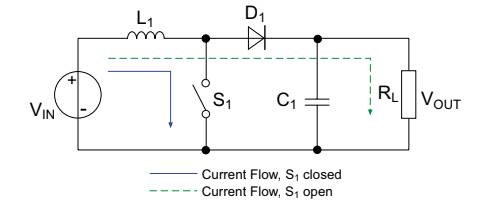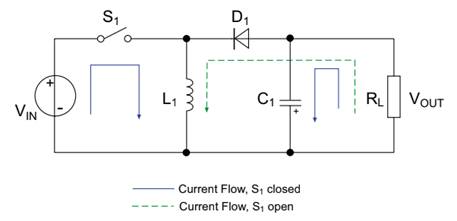Basic principles of step-up, step-down and step-up / step-down converters
Time:2022-09-07
Views:1792
Author: recom power
For many years, switching power conversion has become the pillar of modern electronic technology, covering many fields including public utilities, industry, commerce and consumer market. In low-power DC / DC conversion applications, most modern power conversion is completed by three different types of power converters: boost, buck and buck converters. This paper will study the basic principle and practical application of each converter.
Buck converter is a DC / DC switching power supply, which reduces the non regulated DC input voltage to achieve a stable low output voltage. Compared with the traditional voltage regulator, the buck converter has high efficiency, which can easily exceed 95%, so it is widely valued. The simplified circuit diagram below shows the current path during switching of the buck converter.

Buck converters usually replace the traditional low efficiency linear regulators to provide low-voltage on-board power in various applications, such as microprocessors, communication equipment, and control systems.
What is boost converter?
Boost converter is a kind of DC / DC switching power supply, which raises the non regulated DC input voltage to achieve a stable high output voltage. Similar to buck converters, boost converters rely on inductors, diodes, capacitors and switches to regulate the output voltage, but their configurations are different. The following simplified circuit diagram shows the current path during switching of the boost converter.

In the step-up converter, the output voltage changes according to the ratio of the PWM signal to the on switch, which is equal to or greater than the input voltage. Since power is saved, a boost converter that provides three times the input voltage can only provide one third of the current. However, boost converters are very common in battery powered equipment, for example, a set of 3V battery voltage supplies 5V circuits.
The buck boost converter can provide a stable DC voltage output regardless of whether the input voltage is higher or lower than the output voltage. Buck boost converter circuits combine elements of buck converters and boost converters, but they are usually larger in size than both. The simplified circuit diagram below shows the common current paths during switching of the buck boost converter.

You may find that the polarity of the output voltage in the circuit diagram is opposite to the input voltage, which will complicate the design. Buck boost converters also require more expensive devices because they have to withstand both high voltage when the highest voltage is input and high current when the lowest voltage is input. However, the buck boost converter is very suitable for a variety of applications, the most common of which is high-power LED lighting. For example, lead-acid batteries provide a nominal 9-14v voltage for a 12V LED constant load.
conclusion
The technology of step-down, step-up and step-up converters is widely used in the world, and DC / DC power supplies that provide low-voltage voltage stabilization can be seen in almost every electronic market. Recom‘s buck, boost and buck converters are the best solution to meet your low power conversion needs.
|
Disclaimer: This article is transferred from other platforms and does not represent the views and positions of this site. If there is infringement or objection, please contact us to del |











